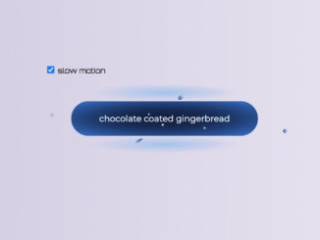Here’s how to create a visually engaging Gravity Button Using Pure CSS, without relying on JavaScript for the core animation. This tutorial will guide you through the process step-by-step, from setting up your HTML structure to styling the button with CSS for a stunning “gravity” effect.
Setting Up the Document Header
The first step involves including the necessary fonts and potentially any CSS preprocessors in the “ of your HTML document. These assets enhance the button’s visual appeal and ensure cross-browser compatibility.
<link rel="preconnect" href="https://fonts.googleapis.com"> <link rel="preconnect" href="https://fonts.gstatic.com" crossorigin> <link href="https://fonts.googleapis.com/css2?family=Montserrat&family=Orbitron&display=swap" rel="stylesheet"> <script src="https://public.codepenassets.com/js/prefixfree-1.0.7.min.js"></script>
Creating the HTML Structure
Next, define the HTML structure for the gravity button and the slow-motion checkbox. The button includes spans for the particles, which will be animated to create the gravity effect.
<input id="slow" type="checkbox"/> <label for="slow">slow motion</label> <button>chocolate coated gingerbread<span class="wrap" aria-hidden="true"><span class="particle" style="--a: -45deg; --x: 53%; --y: 15%; --d: 4em; --f: .7; --t: .15"></span><span class="particle" style="--a: 150deg; --x: 40%; --y: 70%; --d: 7.5em; --f: .8; --t: .08"></span><span class="particle" style="--a: 10deg; --x: 90%; --y: 65%; --d: 7em; --f: .6; --t: .25"></span><span class="particle" style="--a: -120deg; --x: 15%; --y: 10%; --d: 4em"></span><span class="particle" style="--a: -175deg; --x: 10%; --y: 25%; --d: 5.25em; --f: .6; --t: .32"></span><span class="particle" style="--a: -18deg; --x: 80%; --y: 25%; --d: 4.75em; --f: .5; --t: .4"></span><span class="particle" style="--a: -160deg; --x: 30%; --y: 5%; --d: 9em; --f: .9; --t: .5"></span><span class="particle" style="--a: 175deg; --x: 9%; --y: 30%; --d: 6em; --f: .95; --t: .6"></span><span class="particle" style="--a: -10deg; --x: 89%; --y: 25%; --d: 4.5em; --f: .55; --t: .67"></span><span class="particle" style="--a: -140deg; --x: 40%; --y: 10%; --d: 5em; --f: .85; --t: .75"></span><span class="particle" style="--a: 90deg; --x: 45%; --y: 65%; --d: 4em; --f: .5; --t: .83"></span><span class="particle" style="--a: 30deg; --x: 70%; --y: 80%; --d: 6.5em; --f: .75; --t: .92"></span></span></button>
Styling the Button with CSS
This section provides the CSS code required to style the button, including the gravity animation, colors, and overall appearance. The CSS uses custom properties and keyframes to create the particle animation effect.
@charset "UTF-8";
@property --k {
syntax: "<number>";
initial-value: -1;
inherits: true;
}
html, body {
display: grid;
}
html {
height: 100%;
}
body {
place-content: center;
overflow-x: hidden;
}
button {
--m: 1;
grid-area: 2/1/span 1/span 2;
position: relative;
margin: 1em;
border: solid 2em transparent;
padding: 1.5em 3.25em;
border-radius: 5em;
box-shadow: inset 0 0 1px #23429e;
background: radial-gradient(#111a39, 67.5%, #3476da) padding-box, radial-gradient(#a0c2ed, 35%, #a0c2ed00 70%) 50% 0/80% 50% repeat-y;
color: #f2fdfe;
font: 700 1.5em/1 montserrat, sans-serif;
}
#slow:checked ~ button {
--m: 5 ;
}
button:active {
translate: 0 2px;
}
@keyframes k {
0%, 33.3% {
--k: 1 ;
}
}
.particle {
--f: 1;
--pos-k: max(0, var(--k));
--neg-k: max(0, -1*var(--k));
--low-c: min(1, 4*(1 - var(--pos-k)));
--abs-d: max(var(--neg-k) - .5, .5 - var(--neg-k));
--mov-f: var(--pos-k);
display: grid;
position: absolute;
left: var(--x);
top: var(--y);
rotate: var(--a);
animation: k calc(var(--m)*1s) linear calc(var(--m)*var(--t, 0)*1s) infinite;
}
@supports (scale: sqrt(4)) {
.particle {
--mov-f: sqrt(var(--pos-k)) ;
}
}
.particle::before, .particle::after {
grid-area: 1/1;
width: 0.75em;
aspect-ratio: 1;
}
.particle::before {
--sa: calc(min(1, 1 - 2*min(.5, var(--mov-f)))*45deg);
border-radius: calc(1.25*min(.8, var(--mov-f))*50%) 50% 50%;
transform-origin: 0 0;
translate: calc(var(--mov-f)*var(--d));
rotate: -45deg;
scale: var(--f);
transform: skew(var(--sa), var(--sa));
opacity: var(--low-c);
filter: Saturate(var(--low-c));
background: radial-gradient(at 85% 85%, #bad9fa, #3e66a4 75%);
content: "";
}
.particle::after {
translate: -50% -50%;
scale: calc(var(--f)*(1 - 2*var(--abs-d)));
text-align: center;
filter: blur(0.5px);
content: "✦";
}
[type=checkbox] {
justify-self: end;
margin: 5px;
width: 1em;
aspect-ratio: 1;
}
[type=checkbox], [type=checkbox] + label {
align-self: center;
font: 1.25em orbitron, monospace;
cursor: pointer;
}

